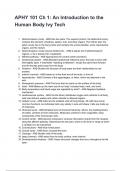Exam (elaborations)
APHY 101 Ch 1: An Introduction to the Human Body Ivy Tech Questions and Verified Rationalized Answers, 100% Guarantee Pass 2025/2026
- Course
- Institution
APHY 101 Ch 1: An Introduction to the Human Body Ivy Tech Questions and Verified Rationalized Answers, 100% Guarantee Pass 2025/2026
[Show more]




